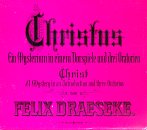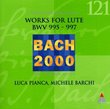| All Artists: Draeseke, Follert, Breslau State Philharmonic Title: Christus Mysterium Members Wishing: 0 Total Copies: 0 Label: Bayer Release Date: 3/24/1995 Album Type: Import Genre: Classical Style: Opera & Classical Vocal Number of Discs: 5 SwapaCD Credits: 5 UPC: 750582933929 |
Search - Draeseke, Follert, Breslau State Philharmonic :: Christus Mysterium
CD DetailsSimilar CDs
|
CD ReviewsChristus: Mysterium in an Introduction and Three Oratorios Sanpete | in Utah | 07/01/2008 (5 out of 5 stars) "This is a work that is little known and even less well understood. This recording, the only one ever made, hasn't led to a great rush of popularity, but I think it presents the work well, and I expect (or hope for) the work and the recording to gain more respect as they become better known. Felix Draeseke (1835-1913) was a leading composer and musical intellectual in his day, well admired by his contemporaries, especially von Bulow, Liszt and Wagner. Through much of his career he suffered from hearing problems, which prevented his chosen career as a conductor, and led in his later years to almost complete deafness. He began as a champion of new trends in music, with a reputation as a firebrand, and ended as a guardian of established taste, railing against the immorality of Richard Strauss's Salome. He composed in a broad array of forms, including opera, symphonies, solo piano and chamber music. His work is undergoing a revival after decades of obscurity. The text for the Christus Mysterium was assembled beginning in 1864, after Draeseke had composed other orchestral and choral pieces, but he felt unprepared to compose this one. He especially wanted to learn more about counterpoint, no doubt thinking of models like Bach. He returned to the project beginning on Easter Sunday, 1895, completing it in the winter of 1899. Despite being well received, only two complete performances were mounted, in 1912, until this recording. This set comes with extensive notes, including the composer's own introduction. Draeseke begins with an explanation of the title "Mysterium," a reference to the medieval mystery plays about the life (the mystery) of Christ. The Christus is a comprehensive presentation of the life and teachings of Jesus, with all texts taken directly from scripture. The events are in order, but there is liberal use of textual interpolations taken from scripture outside the gospel narratives. It differs from the old mystery plays in not acting out the parts, but rather singing them from sheet music in the manner of oratorio. He notes the ties of oratorio to opera, but clearly wants to avoid operatic musical elements that would be inappropriate to his religious purpose. The Christus has much in common with Bach's passions in purpose and form, but is much broader in scope and isn't intended for liturgical use. Draeseke had very definite ideas about what styles of music, and even which instruments, are suitable to churches and religious purposes, which make claims of broad similarities to secular works (such as Wagner's) somewhat misleading. He makes limited use of leitmotifs. Considering all Draeseke says, in terms of form and style, the Christus should probably be regarded as a unique effort to update, expand and reign in oratorio. The scale of the work is massive by most standards, at about five hours, but it's designed to be performable in more easily staged and digested parts. If all performed, it was intended to be presented over three evenings. The first complete performance, which Draeseke attended, took place on three consecutive Tuesdays. The music is congenial, inviting, dramatic, beautiful, well constructed, with much pleasing counterpoint, for which Draeseke had become well known in the years since first conceiving the project. It has far more appeal and interest throughout than the typical string of dry recitatives we might have expected. There aren't the glorious high points of memorable melody such as we get in Handel's Messiah, but that's true of 99% of oratorio, even Handel's. You can hear period influences, and as much from what came before. Draeseke wanted a chorus of at least 400 if possible (!), with a moderate orchestra, but the choral and orchestral parts aren't heavy, rather light and springy for the period. The mood of some of the music is quite sunny. You can hear a thousand flowers bloom in parts of the recital of the Beatitudes, for example. Often the mood is positively joyous, particularly in the many celebratory choruses throughout the work. Naturally, among the most rousing examples are the last two choruses, one the final resurrection chorus, the other singing of Jesus' ascension and eventual return, with a Hallelujah and Amen. They have some of the color of Wagner at times, but the vigor and joy of Handel. There are darker parts too. The "crucify him!" shouted by the Jews is like knives stabbing. (We aren't spared what might be regarded as the anti-Jewish side of the story as related in the gospels. "His blood will be on us and our children" is used twice, once as the last word of the crucifixion section.) Parts of the temptation of Jesus by Satan, and the chorus of wicked spirits leading up to it, are played out like a medieval battle. (Draeseke explains that he exceeded the bounds of what he saw as proper church music in this section, but he felt in the context of the work as a whole it was still appropriate for performance in churches.) Other parts of that section show Satan and his hosts being more subtle and beguiling. Jesus, on the other hand, is simply firm, backed by triumphant orchestral passages. In the chorus following the raising of Lazarus, the light and dark are mixed, as the faithful, joined by angels, overcome undertones of murmuring Scribes and Pharisees in glorious fugal struggle, an effective device repeated later. Elsewhere there are flashes of music that might accompany Errol Flynn swashbuckling. There is no lack of variety. Good use is made of hymn tunes, but primarily in instrumental passages, on the peculiar grounds that it would be impossible for them to be sung by the characters of the era portrayed. That reasoning is silly as given, but perhaps it works to the advantage of the goal of the piece, in that the text gains an extra measure of new life being put to unfamiliar tunes. Draeseke does nonetheless sometimes allow the vocal music to be influenced by hymn tunes, and he even works the tunes into the fabric of some choruses. A fine and particularly affecting example of hymn use is the beautiful Passion Chorale ("O Haupt voll Blut und Wunden" or "O Sacred Head, Now Wounded"), played wordless with spare instrumentation to mark the moment of the crucifixion, which is characterized here by profound sadness and meekness intruded on by the cruelty of mockers. Though the tune disappears in the vocal music that follows, its influence is still heard; it reappears in the instrumental passages. In general, the music reflects, not always in a very subtle way, a mood or moods one might associate with each bit of text, often interpreted more dramatically or with more feeling than I've imagined it before. I find it occasionally jarring to my preconceptions but quite effective at bringing the text to life. And that is, of course, the goal. The performance on this CD set is quite good, especially considering the taxing extent of the project. The main vocal soloists are solid and pleasing and sing with good feeling for the text and music. Phillip Langshaw, in particular, who sings the part of Jesus, does a very difficult job very well. His baritone is well shaped, secure and strong enough to match the demands throughout. The orchestral support is fine, and the chorus is always most enjoyable; both perform fervently. Conductor Udo-R. Follert must have done prodigious work assembling this performance. I think he does the music justice, a most commendable accomplishment. The booklet that comes with this set includes general notes about the work and its composer, a synopsis, musical analysis and, most essential, the full libretto, with biblical source citations. All but the libretto are in German, English and French; the libretto is only in German and English. The German and English libretti are in separate sections, making it a little more difficult to follow along for those who can understand only limited German. Examples of the score referred to in the notes are found only in the German section. The Christus ought to be of particular interest to ambitious musical groups who would put on a piece like a Bach passion. As with the Bach passions, the language is a barrier to full appreciation by non-German speakers, but a good written program or, better, supertitles, would make the experience worthwhile. I'd love to experience it live myself. It's probably necessary to love, or be willing to love, the texts to really enjoy this piece. It has an abundance of musical interest, but what propels and sustains it, as intended, are the words and their meaning. I bought this years ago, sampled it, and set it aside without much appreciation because I just didn't have the time or attention necessary. Having now heard the whole, in several sittings over a couple weeks, with a focus on the words, I found myself increasingly attuned to the piece, enjoying it more with each installment. It's a rewarding work and performance." Good to listen to once Gerard Sparaco | Little Valley, NY United States | 05/15/2003 (3 out of 5 stars) "The long cycle of oratorios by the completely forgotten Felix Draeseke is interesting to listen to once or twice, and only then as a curiosity. This work sounds like J.S. Bach's St. Matthew Passion as written by Richard Wagner. He makes good use of traditional Lutheran hymns. It is understandable though, why this work has fallen into obscurity (this recording being the first performance of the piece since the early 1900's). Draeseke simply doesn't have the dramatic flair nor the theological insight to make the music intersting."
|




